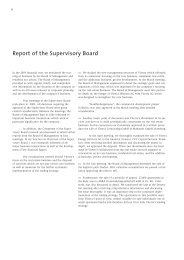E_mg_GB_03_vorne-29_3_04
E_mg_GB_03_vorne-29_3_04
E_mg_GB_03_vorne-29_3_04
You also want an ePaper? Increase the reach of your titles
YUMPU automatically turns print PDFs into web optimized ePapers that Google loves.
MANAGEMENT SHARE STRATEGY SPECIAL SECTION MANAGEMENT REPORT FINANCIAL STATEMENTS FURTHER INFORMATION<br />
GEA’s spray dryers keep the air clean<br />
Economic Environment • Situation of the Company • Organization and Structure • Risk Report • Employees • Performance of the Subgroups • Outlook<br />
GEA’s spray dryers are also used to protect the environment. Although they are really intended to be<br />
used to produce powder, they are also used worldwide in power plants and waste incineration plants<br />
to clean flue gas. Absorption through spray drying is cheap, reliable and complies with the most<br />
stringent emissions protection legislation.<br />
Lurgi: technology for the production of alternative fuels<br />
Lurgi’s industrial plant is used to produce bio-diesel and bio-ethanol from renewable resources such<br />
as rape and grain. Both of these fuels are environmentally friendly alternatives to conventional gasoline<br />
and diesel and help to drastically cut carbon dioxide emissions. Lurgi is the global market leader<br />
in the construction of plant for the production of methanol from gas. Lurgi’s technologies are used to<br />
process the liquid inexpensively into environmentally friendly fuels and fuel additives.<br />
Lurgi Lentjes’ plant converts residual waste and other waste materials into valuable energy<br />
Lurgi Lentjes builds industrial plant that is used to efficiently convert residual waste and other waste<br />
materials into valuable energy. Proprietary flue-gas-cleaning processes ensure that statutory limits<br />
on emissions are not exceeded.<br />
Dynamit Nobel: innovative processes protect the environment<br />
The companies in the <strong>mg</strong> chemical group also make a valuable contribution to protecting the environment.<br />
Dynamit Nobel subsidiary Chemetall, for example, offers its customers innovative processes<br />
that are designed to provide better protection against corrosion of metal surfaces and do not use harmful<br />
heavy metals such as chrome. During the year under review, Dynamit Nobel’s plastics business<br />
started to modernize and retool all of the painting plants at its European sites in order to further cut<br />
the level of emissions.<br />
Research & Development<br />
Operating in an environment of perpetual competition, a technology-driven organization such as the<br />
<strong>mg</strong> Group relies on innovation for its future growth and commercial success. The company therefore<br />
invests heavily in research and development. This includes efficient innovation management and a<br />
forward-looking culture of innovation. As a result, <strong>mg</strong> technologies ag is one of the market and technology<br />
leaders in 90 percent of its businesses, generating almost half of its sales from products that<br />
are no more than three years old.<br />
The <strong>mg</strong> Group continued to spend a considerable amount on research and development in 20<strong>03</strong>,<br />
investing a2<strong>04</strong>.8 million. This was a decrease of a33.3 million on the corresponding period of last<br />
year and accounted for 3.2 percent of total sales (roughly 3.5 percent in 2001/2002). It applied for<br />
186 patents in 20<strong>03</strong>, having applied for 179 in 2001/2002.<br />
In 20<strong>03</strong>, GEA spent approximately a31 million – 1.2 percent of the GEA Group’s total sales – on<br />
proprietary research and development projects. Including development projects conducted in close<br />
cooperation with GEA customers and in connection with specific customer contracts, the total<br />
proportion of its sales spent by GEA on research and development comes to around five percent.<br />
Depending on business line, GEA already generates up to 70 percent of its sales from products<br />
that are less than three years old.<br />
55









